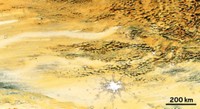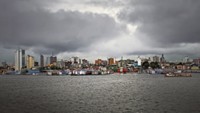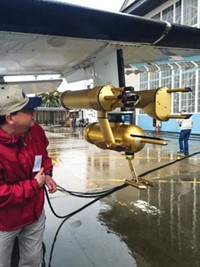Advertisement
Grab your lab coat. Let's get started
Welcome!
Welcome!
Create an account below to get 6 C&EN articles per month, receive newsletters and more - all free.
It seems this is your first time logging in online. Please enter the following information to continue.
As an ACS member you automatically get access to this site. All we need is few more details to create your reading experience.
Not you? Sign in with a different account.
Not you? Sign in with a different account.
ERROR 1
ERROR 1
ERROR 2
ERROR 2
ERROR 2
ERROR 2
ERROR 2
Password and Confirm password must match.
If you have an ACS member number, please enter it here so we can link this account to your membership. (optional)
ERROR 2
ACS values your privacy. By submitting your information, you are gaining access to C&EN and subscribing to our weekly newsletter. We use the information you provide to make your reading experience better, and we will never sell your data to third party members.
Environment
Tiny pollutant particles strengthen thunderstorms
Scientists find that long-ignored ultrafine aerosols can make storms rainier and windier
by Sam Lemonick
February 5, 2018
| A version of this story appeared in
Volume 96, Issue 6

Researchers studying thunderstorms in the Amazon rain forest have found that tiny pollution particles—each about one-ten thousandth the size of the period at the end of this sentence—can boost the power of storms (Science 2018, DOI: 10.1126/science.aan8461).
Sulfates, nitrogen oxides, volatile organic compounds, and other molecules can conglomerate into these ultrafine aerosol particles (UAPs), which are less than 50 nm across. Scientists have long known that aerosol particles larger than 50 nm serve as seeds for cloud formation, but most researchers have discounted the role of UAPs in storm clouds because they thought the particles were too small to nucleate water droplets from moisture in the air.
Jiwen Fan of Pacific Northwest National Laboratory and colleagues found otherwise. While larger particles nucleate droplets at the base of storm clouds, UAPs can nucleate droplets 2.5–3 km up from the base. When the water condenses, it releases heat, which can push the tops of clouds higher and increase wind speeds.
The Amazon rain forest has very low levels of UAPs naturally, but the Brazilian city of Manaus in the heart of the Amazon basin produces a plume of pollution that flows with the prevailing winds over the pristine rain forest. In 2014 and 2015, an international team of researchers led by Scot Martin of Harvard University tracked air quality near Manaus from planes and ground stations.
Fan’s group looked at cloud data collected in that effort. The researchers found that vertical wind velocity and reflectivity—a proxy for the amount of precipitation—as measured by radar increased with growing concentrations of UAPs.
Fan says studying UAPs has long been a challenge because it’s difficult to separate their effects from other variables in storm clouds, such as humidity, temperature, and wind. Thanks to shifting wind patterns in the Amazon basin, her team could compare thunderstorms that were nearly identical except for the presence or absence of UAPs from Manaus.
“In this study we have this perfect setting,” Fan says. “During the wet season, many of the storms are happening under very similar meteorological conditions, except for aerosol.”
Joel Thornton, an atmospheric chemist at the University of Washington who was not involved in the study, hopes the study will spur others to take a closer look at UAPs. “What this paper does is raise the stakes in needing to develop a deeper, more accurate understanding of the sources and fates of atmospheric UAPs than we currently have,” Thornton says.





Join the conversation
Contact the reporter
Submit a Letter to the Editor for publication
Engage with us on Twitter